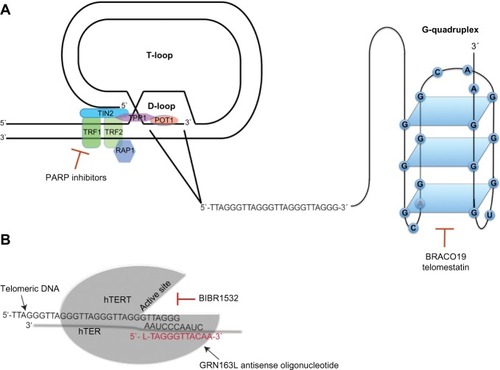Figures & data
Figure 1 Telomeres and telomerase as therapeutic targets.
Notes: (A) Telomeres display a single-stranded G-rich 3′ overhang that is bound by telomeric proteins and forms higher-order structures of telomerase such as T-loop and G-quadruplex that are required for proper telomere maintenance and protection of chromosomal integrity. In addition, a D-loop structure can be observed serving as the primer for telomerase during elongation of telomeres. Six telomere-associated proteins form the shelterin complex that serves as a telomere cap and is involved in the regulation of telomere length. In this context, TRF1 serves as a negative regulator of telomeres that prevents telomerase from telomere access. Therapeutic strategies targeting telomere structures are depicted at their respective site of action. (B) Telomerase comprises the catalytic subunit hTERT and the intrinsic RNA moiety hTER, which serves as a template for the synthesis of telomeric DNA. Telomerase inhibition can be either achieved by blocking of the active site of the enzyme (BIBR1532) or by targeting the RNA template of the enzyme with an antisense oligonucleotide (GRN163L).
Abbreviations: hTER, human telomerase RNA; hTERT, human telomerase reverse transcriptase; PARP, poly (ADP-ribose) polymerase.
Abbreviations: hTER, human telomerase RNA; hTERT, human telomerase reverse transcriptase; PARP, poly (ADP-ribose) polymerase.

Table 1 Therapeutic strategies targeting telomeres and telomerase
